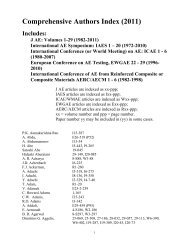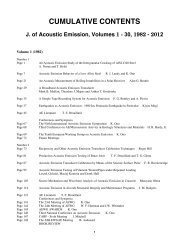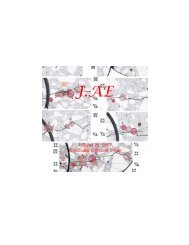- Page 2 and 3: JOURNAL OF ACOUSTIC EMISSIONVOLUME
- Page 4 and 5: 23-196 AE AND ELECTROCHEMICAL NOISE
- Page 6 and 7: Volume 23 (2005) AUTHORS INDEXA. AN
- Page 10 and 11: MEETING CALENDAR:The 49 th Meeting
- Page 12 and 13: code [3-5]. The level of numerical
- Page 14 and 15: 0.6(a)Amplitude, pm0-0.60 0.3 0.6 0
- Page 16 and 17: 10S/N 1 to 20-1010S/N 1 to 1Displac
- Page 18 and 19: Examination of the results in Table
- Page 21: Based on the results in Table 6, we
- Page 24 and 25: Fig. 7 Signal and WT of the signal.
- Page 26: Then the absolute value differences
- Page 29: two modes not being the same and bo
- Page 36 and 37: understand the similitude on damage
- Page 39 and 40: curve. During loading in this direc
- Page 41 and 42: detected (i.e. interfacial debondin
- Page 43 and 44: RTM material in course direction (9
- Page 45 and 46: detected, at higher strain values t
- Page 47 and 48: ACOUSTIC EMISSION DETECTION OF IMPA
- Page 49 and 50: detected from this foam impact even
- Page 51: Foam impact tests were also perform
- Page 55 and 56: Fig. 10 Key components of the Shutt
- Page 57 and 58: MOMENT TENSORS OF IN-PLANE WAVES AN
- Page 59 and 60: equired. So far, numerical solution
- Page 61 and 62: Fig. 4 (a) Shear dislocation model,
- Page 63 and 64: plate-like sample. In this case, th
- Page 65 and 66: 3. IN-PLANE THEORETICAL WAVEFORMS3.
- Page 67 and 68: Fig. 11 Source model of out-of-plan
- Page 69 and 70: Fig. 13 Slit model for a defect (di
- Page 71 and 72: the large events, of which first ar
- Page 73 and 74: Fig. 18 Crack orientations for shea
- Page 75 and 76: the precise control of the gap leng
- Page 77 and 78: 3. Design and Fabrication of the Se
- Page 79 and 80: Fig. 7: Interferometeric pattern fo
- Page 81 and 82:
Fig. 9: Trace and power spectral de
- Page 83 and 84:
2. Optical Fiber AE Sensor SystemA
- Page 85 and 86:
Fig. 4 Detected waves by the develo
- Page 87 and 88:
Fig. 10 Sensitivity distribution of
- Page 89 and 90:
Fig. 14 Experimental setup for dete
- Page 91 and 92:
HIGH PRECISION GEOPHONE CALIBRATION
- Page 93 and 94:
Fig. 3 Geophone response.the amplit
- Page 95 and 96:
Fig. 11 Imagenary short circuit.Fig
- Page 97 and 98:
Re22S0 12 0m0 0Z1= r +(14)222( )
- Page 99 and 100:
from G3. A geophone shakes the enti
- Page 101 and 102:
DEVELOPMENT OF HEAT-RESISTANT OPTIC
- Page 103 and 104:
2. Experiments2.1 Optical Fiber Sen
- Page 105 and 106:
Fig. 7 Detected quasi-AE waves.Fig.
- Page 107 and 108:
2. Outline of Damage Detection Syst
- Page 109 and 110:
Fig. 5 Outline of specimen (RN47) a
- Page 111 and 112:
2) The damage index transmitted fro
- Page 113 and 114:
microscopy [e.g., 1] or optical mic
- Page 115 and 116:
MPa. Under these conditions, a rock
- Page 117 and 118:
3. Damage Model Based on Sub-Critic
- Page 119 and 120:
in a positive relation. The larger
- Page 121 and 122:
well by the theoretical model consi
- Page 123 and 124:
MEASUREMENT OF HYDRAULICALLY ACTIVA
- Page 125 and 126:
Fig. 1 Source locations of induced
- Page 127 and 128:
P C means the increase of fluid pre
- Page 129 and 130:
A MODELING METHOD ON FRACTAL DISTRI
- Page 131 and 132:
as constant, Eight sensors were sel
- Page 133 and 134:
The number of AE events tends to de
- Page 135 and 136:
Fig. 10 Plan view of longwall minin
- Page 137 and 138:
Fig. 14 Crack distribution model of
- Page 139 and 140:
INTERPRETATION OF RESERVOIR CREATIO
- Page 141 and 142:
Fig. 2: Pumping data during the fir
- Page 143 and 144:
4. Focal MechanismWe observed the p
- Page 145 and 146:
AcknowledgementsThe seismic monitor
- Page 147 and 148:
Fig. 1 Arrangement of AE sensors an
- Page 149 and 150:
surface crack. Relations between AE
- Page 151 and 152:
4. ConclusionThe traces of the surf
- Page 153 and 154:
2. Sliding Experiments Using a Rock
- Page 155 and 156:
AE events accompanying sliding were
- Page 157 and 158:
though a limited number of m-values
- Page 159 and 160:
indicator for the contact state of
- Page 161 and 162:
2. Experimental Procedures2.1 Prepa
- Page 163 and 164:
Fig. 4 AE generation behavior and c
- Page 165 and 166:
1) The crack growth behavior under
- Page 167 and 168:
Fig. 1 AE monitoring system for cyc
- Page 169 and 170:
Fig. 4 (a) Surface photograph of in
- Page 171 and 172:
Fig. 8 Depth at lateral crack initi
- Page 173 and 174:
µm from the surface. This depth ag
- Page 175 and 176:
Fig. 1Conceptofthisstudy.following
- Page 177 and 178:
(b) By comparing the features in th
- Page 179 and 180:
ange K. From this result, it is und
- Page 181 and 182:
Figure 9 shows the relationship bet
- Page 183 and 184:
ACOUSTIC EMISSION BEHAVIOR OF FAILU
- Page 185 and 186:
Fig. 1. Statistical result of stren
- Page 187 and 188:
The AE signals indicating the onset
- Page 189 and 190:
occurrence of individual mechanisms
- Page 191 and 192:
ROLLING CONTACT FATIGUE DAMAGE OFWC
- Page 193 and 194:
and by 1.8 dB at 1 MHz. Without the
- Page 195 and 196:
Fig. 7 Sectional view of grooves at
- Page 197 and 198:
The analyzed locations are distribu
- Page 199 and 200:
BORON EFFECTS ON AE EVENT RATE PEAK
- Page 201 and 202:
Fig. 1 Stress-strain curves, AE eve
- Page 203 and 204:
Fig. 4 Relation between AE active s
- Page 205 and 206:
(2) Boron has a large strengthening
- Page 207 and 208:
produced during loading. Indentatio
- Page 209 and 210:
Fig. 3 Typical AE waveforms detecte
- Page 211 and 212:
formation. Thus, the crack morpholo
- Page 213 and 214:
Fig. 11 Examples of RD-type ENs wit
- Page 215 and 216:
(4) R. Ikeda, Y. Hayashi, M. Takemo
- Page 217 and 218:
averaged over a certain duration. O
- Page 219 and 220:
Fig. 3 Wavelet transform of continu
- Page 221 and 222:
Parameters used in time-series anal
- Page 223 and 224:
a minor contribution, but keeps the
- Page 225 and 226:
PRECURSOR OF HYDROIGEN INDUCED GLAS
- Page 227 and 228:
Table 1 Acoustic and elastic proper
- Page 229 and 230:
Fig. 5 Surface and transverse sketc
- Page 231 and 232:
Fig. 9 Chipped glass lining and sou
- Page 233 and 234:
ground coat. Crack volume and rise
- Page 235 and 236:
Figure 1 shows a schematic image of
- Page 237 and 238:
According to this process, the loca
- Page 239 and 240:
Fig. 5 Orientation dependence of th
- Page 241 and 242:
Fig. 9 Example of detected AE signa
- Page 243 and 244:
INVESTIGATION ON AE SIGNAL/NOISE PR
- Page 245 and 246:
Fig. 2 History of AE hit rates (upp
- Page 247 and 248:
Fig. 6 Source location of AE data i
- Page 249 and 250:
Fig. 9 Amplitude (upper) and hit ra
- Page 251 and 252:
Fig. 12 Amplitude (upper) and hit r
- Page 253 and 254:
EXAMINATION OF AE WAVE PROPAGATION
- Page 255 and 256:
Fig. 3 Waveguide for in water AE so
- Page 257 and 258:
and the rest through water, the obs
- Page 259 and 260:
INTEGRITY EVALUATION OF GLASS-FIBER
- Page 261 and 262:
Fig. 2 Deformation of GFRP vessel w
- Page 263 and 264:
Fig. 6 Load-deflection curves and c
- Page 265 and 266:
3.1 Test Vessels and Experimental P
- Page 267 and 268:
Fig. 12 Typical AE waves for vessel
- Page 269 and 270:
Fig. 15 Correlation between AE dura
- Page 271 and 272:
Fig. 1. Railway concrete piers to b
- Page 273 and 274:
Fig. 4 Arrangement of AE sensors wi
- Page 275 and 276:
5.2 Acoustic EmissionFig. 7 Develop
- Page 277 and 278:
Fig. 9 AE sources in three-dimensio
- Page 279 and 280:
Fig. 13 Amplitude distributions in
- Page 281 and 282:
4) T. Yasuda, S. Taniguchi, S. Kame
- Page 283 and 284:
Fig. 1 Water leakage in a joint sec
- Page 285 and 286:
A-FRQ(kHz)800600400200Normal Sectio
- Page 287 and 288:
ACOUSTIC EMISSION FOR FATIGUE DAMAG
- Page 289 and 290:
Fig. 3 Group velocity dispersion cu
- Page 291 and 292:
thick flange as shown in Fig. 8. Th
- Page 293 and 294:
Fig. 13 Relationship between load P
- Page 295 and 296:
PLASTIC REGION BOLT TIGHTENING CONT
- Page 297 and 298:
3. Experimental Results3.1 Result f
- Page 299 and 300:
4. Discriminant AnalysisMany noise
- Page 301 and 302:
Fig. 13 Cumulative AE counts select
- Page 303 and 304:
intra-grain mechanism, can also tak
- Page 305 and 306:
(a)(b)(c)(d)Fig. 4 AEsignals during
- Page 307 and 308:
where (σ - σ y ) is the decrease
- Page 309 and 310:
AN ACOUSTIC EMISSION TEST SYSTEM FO
- Page 311 and 312:
Fig. 1 Oxygen cylinder test system.
- Page 313 and 314:
5. Sensor FixtureThe sensor fixture
- Page 315 and 316:
Fig. 5 A block diagram of the test
- Page 317 and 318:
10. Experimental ResultsSeventy-one
- Page 319 and 320:
3. There was no indication at all o
- Page 321 and 322:
such modulated waveforms is difficu
- Page 323 and 324:
temperature distribution of the sam
- Page 325 and 326:
4.2 AE BehaviorFigure 4 shows a typ
- Page 327 and 328:
elatively low densification range.
- Page 329 and 330:
analysis applied for the evaluation
- Page 331 and 332:
• AE hits (Patterns) in the same
- Page 333 and 334:
3. Limitations, Errors and Classifi
- Page 335 and 336:
friction at the time just before th
- Page 337 and 338:
5. Pressure Spheres-AE/PR Case Stud
- Page 339 and 340:
6. Reactor Cool-Down - AE/PR Case S
- Page 341 and 342:
THE ACOUSTIC EMISSION HALON 1301 FI
- Page 343 and 344:
adius of the sphere). This definiti
- Page 345 and 346:
Second: any test, which did not det
- Page 347 and 348:
Fig. 3 Distribution of located even
- Page 349 and 350:
The spacing between the clusters on
- Page 351 and 352:
This test is included as the system








